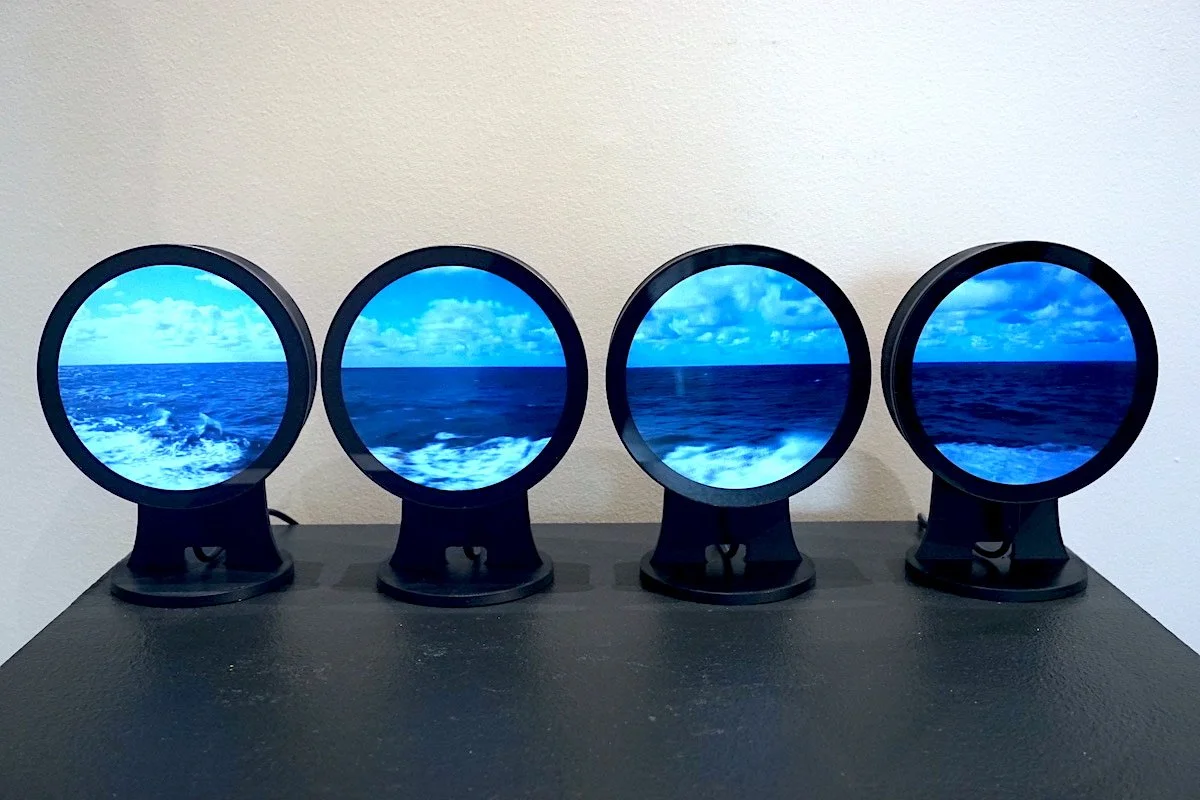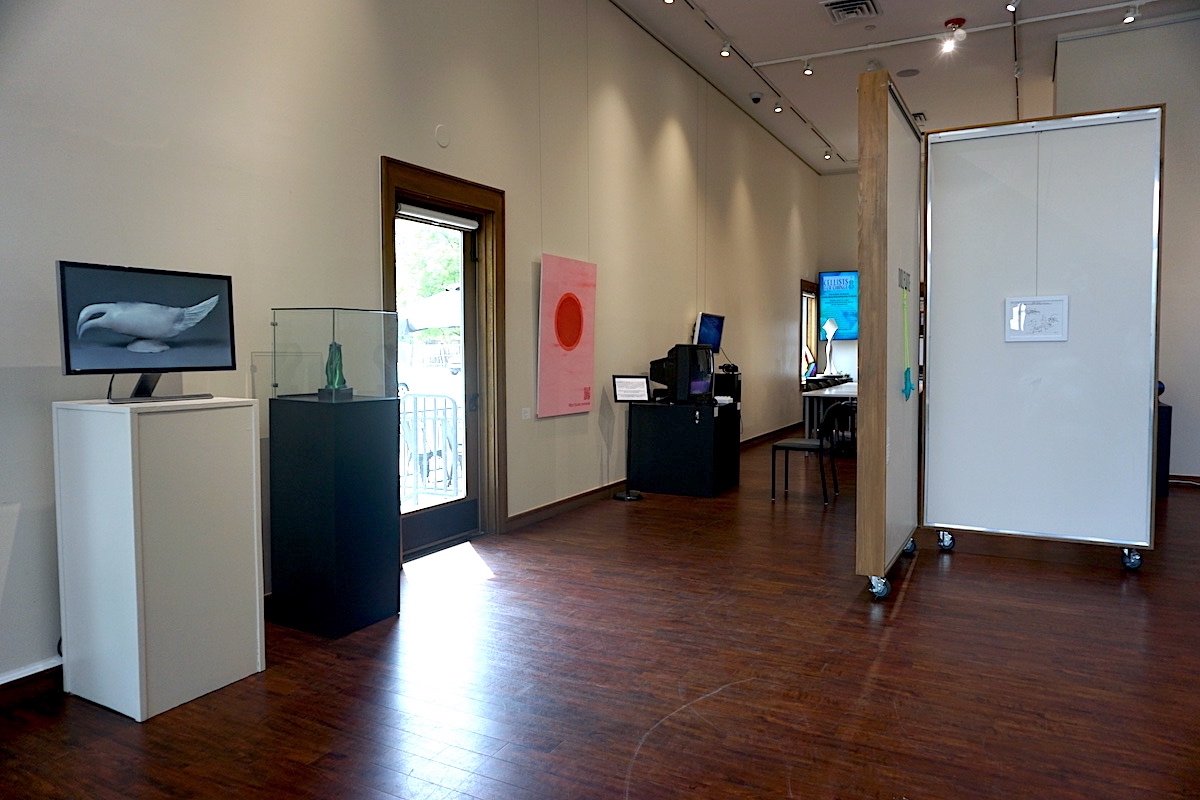RECESS
RECESS
The Collective Community Arts Center
201 N. Public Road, Lafayette, CO 80026
May 14–July 13, 2025
Admission: Free
Review by Madeleine Boyson
I have come to expect sensory overload with most new media art. I do not mean “overload” pejoratively; rather, I find the genre’s capricious instabilities inherent to the work and the world it was born in, reflects, analyzes, and critiques. I know that digital work often requires multisensory digestion—an embodied connection I find welcome in a world brimming with culturally flattened images. I like that new media unsettles me.
An installation view of RECESS, part of LEAF2025 by the Lafayette Electronic Arts Festival at The Collective Community Arts Center in Lafayette, Colorado. Image by Madeleine Boyson.
Yet there is noise (a word meant descriptively and derogatorily, yet entirely subjectively) that I anticipate in digital art exhibitions. [1] Despite my excitement, I expected an impersonal cacophony to greet me at the doors of RECESS at The Collective Community Arts Center in Lafayette, on view through July 13, 2025. Looking back at the line-up, I should have known better.
An installation view of Andy DiLallo and Ian Anderson, Terminal Sequence, interactive video with sound. Image courtesy of Andy DiLallo, from the artists’ NO VACANCY residency in Fall 2024.
RECESS gathers fourteen Colorado-based artists who probe “media and their entanglements—with nature itself, culture and its wars, and the more/other than human.” The exhibition is part of LEAF2025 (Lafayette Electronic Arts Festival), a yearly showcase that celebrates new media and emergent art, featuring names synonymous with the genre in this state.
Julia Edith Rigby, Sea Cave Recess, sound art and video. Image by Madeleine Boyson.
While RECESS is not the “big reassuring hug” that LEAF2025 posits—the exhibition is better likened to a weighted blanket that produces therapeutic pressure—it achieves deliberative space for technology as mediation. RECESS is superb for contemporary and traditional art lovers alike, creating and closing loops between known and unknown collaborators.
Brian Kane, Midwest Modern, high-density foam, epoxy, auto body paint, and glass. Image by Madeleine Boyson.
The Collective’s compact floor space belies restrained complexity. Each work deserves a meaningful amount of time to process. Near the door and Brian Kane’s “lifestyle” coffee table titled Midwest Modern (a giant packing peanut with a maquette of itself), Edem Dotse exhibits his single-channel installation on a chipped Toshiba television.
Edem Dotse, Machine Being Reborn, single-channel audiovisual installation. Image by Madeleine Boyson.
A still from Edem Dotse, Machine Being Reborn, single-channel audiovisual installation. Image courtesy of the artist.
Machine Being Reborn samples Ghanaian archival footage intended to inspire communion “with something that lives beyond both the circuit and the soul.” This brief inevitably folds in on itself and becomes a nuanced third space via hazy images and incoherent noises (in the descriptive sense) that bleed over each other, garnering just enough discomfort to keep watching. [2]
Andy DiLallo and Ian Anderson, Terminal Sequence, interactive video with sound. Image by Madeleine Boyson.
Across the room stands Andy DiLallo and Ian Anderson’s unbelievably funny Terminal Sequence. The interactive game parodies and projects a not-so-distant-future space of the chronically online. Accompanied by the eerie recording of an artificially constructed host, players choose avatars through which they may experience the total collapse of all meaning. “You want an emotional resilience that you can’t seem to make time for,” accuses the AI. After playing, I only wish that I had never heard the phrase “Internet as Daddy” and that subtitles had been provided.
August Black and Nima Bahrehmand, The Feeders, from The End of Us, multimedia installation. Image by Madeleine Boyson.
August Black and Nima Bahrehmand, The Feeders, from The End of Us, multimedia installation. Image courtesy of August Black.
Next comes The Feeders from August Black and Nima Behrehmand’s research project The End of Us, which utilizes the grubs fed to lizards. Here the artists explore ecological circuits via Zophobas morio, superworms capable of digesting non-biodegradable polystyrene (Styrofoam®). From an ant-farm-esque enclosure to a 24-hour livestream of the worms burrowing through their habitat, Black and Behrehmand blur the edges of scientific and artistic fields, questioning our assumptions about decomposition and social conventions.
Laleh Mehran, Fluid Strata, single-channel video (AI-augmented) and 3-D print. Image by Madeleine Boyson.
Brook Vann and August Black, Pulse Memorial, web-based multi-channel sound installation and painting. Image courtesy of August Black.
Leaving the bugs to wriggle, viewers meet Laleh Mehran’s Fluid Strata, an “AI-augmented” video and 3-D printed form that reimagines a historical water vessel in fluid clumps and iridescent green shine. [3] To the right, Brook Vann and August Black’s Pulse Memorial is a web-based, multichannel installation and painting best experienced as a mobile acoustic environment with at least seven other listeners and conspicuously uninteresting with just one.
View of (left to right): Brook Vann and August Black, Pulse Memorial, web-based multi-channel sound installation and painting; Leah Bertrand and Ricky Covell, Vapor Mirror Feedback, interactive audiovisual; and Julia Edith Rigby, Sea Cave Recess, sound art and video. Image by Madeleine Boyson.
Vapor Mirror Feedback by Leah Bertrand and Ricky Covell, by contrast, focuses on individual encounters, connecting noise (in the derogatory sense) with image and looping both on a far subtler scale. Equally delicate yet more soothing is Julia Edith Rigby’s Sea Cave Recess, which draws from five years of video and audio taken in and around sea caves along the United States’ western coast.
Brian Kane, Voyage, electronics, plastic, video, and audio. Image by Madeleine Boyson.
Sharifa Lafon, Echo and Narcissus, video. Image by Madeleine Boyson.
And subtlety persists in Brian Kane’s Voyage—four miniature portholes looking out on the ocean—and Sharifa Lafon’s Echo and Narcissus, a silent time-lapse of the Narcissus papyraceus (Paperwhite Narcissus).
David Fodel, Unfolding Portraits, aluminum extrusion, rubber, NIR LEDs, electronics, and video. Image by Madeleine Boyson.
Similarly refined but more interactive is David Fodel’s 1-pixel-wide image-maker that line-scans viewers and reveals ever-changing images on a rolling screen.
Jeremy Bailey, Patent 8, india ink on paper. Image courtesy of the artist.
A detail view of Jeremy Bailey, Dolflute 1, 2025, PLA, lasers, and bubble fluid. Image by Madeleine Boyson.
Capping off the show and stealing a bit of light at the center of the room is Jeremy Bailey’s Patent 8 (2014) and Dolflute 1 (2025), a patent for and the product of an “apparatus for the electronic consumption of nicotine from a dolphin-shaped flute synthesizer, bubble machine, [and] multimedia projector.”
An installation view of RECESS, part of LEAF2025 by the Lafayette Electronic Arts Festival at The Collective Community Arts Center in Lafayette, Colorado. Image by Madeleine Boyson.
RECESS is intended to mark a “recess” for deliberation and adventure into the “recesses of our minds.” Yet much like the other works in the exhibition, Bailey’s Dolflute and patent have more to do with loops and our expectations for the universe’s cycles and less to do with that period in a school day that allows children to play. Which came first, the patent or the product? In RECESS, it’s clear that it’s the question, and not the answer, that matters.
Madeleine Boyson (she/her) is a Denver-based writer, poet, and artist. She holds a BA in art history and history from the University of Denver and makes her living as a communications and editorial coordinator and arts writer.
[1] I think now of Digital Witness: Revolutions in Design, Photography, and Film at the Los Angeles County Museum of Art through July 13, 2025, an overwhelming show in which works played openly in the gallery, causing me to sweat, cover my ears, and bail on the two-hundred-person exhibition.
[2] As with most of the other audio-inclusive works in the exhibition, viewers are provided an over-the-ear headset to engage with Dotse’s work and instructed to follow one of the gallery’s frequent injunctions to “Please interact!”
[3] “Do you think she was AI?” asked another visitor after experiencing DiLallo and Anderson’s Terminal Sequence. I find that I am suitably thrown by the use of artificial intelligence throughout RECESS, though it is not unusual for emergent media artists to utilize this technology. Perhaps it is because I am so vocal as an opponent of artificial intelligence outside of artistic spaces that the cognitive dissonance of adopting a binary stance forces me to reconsider its uses inside these spaces.

























